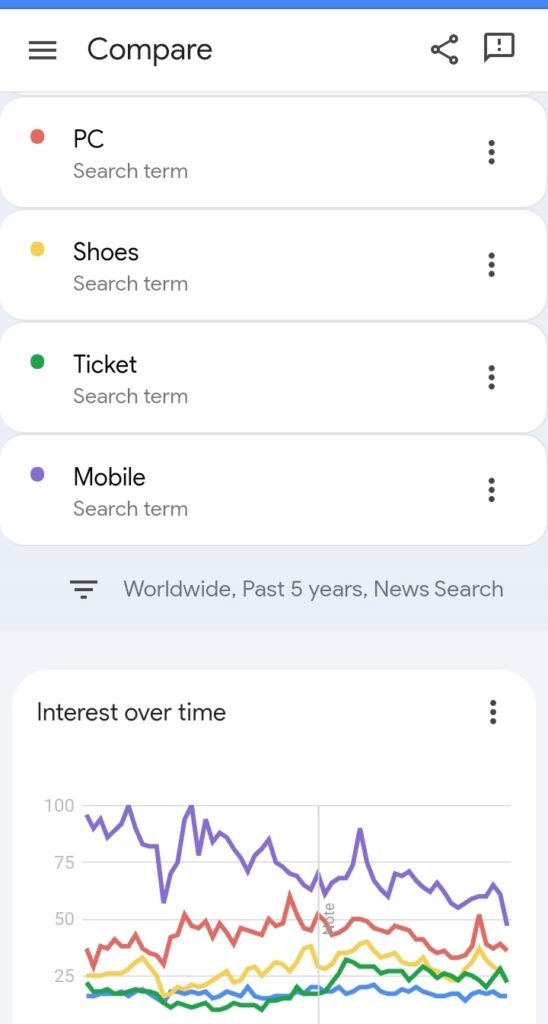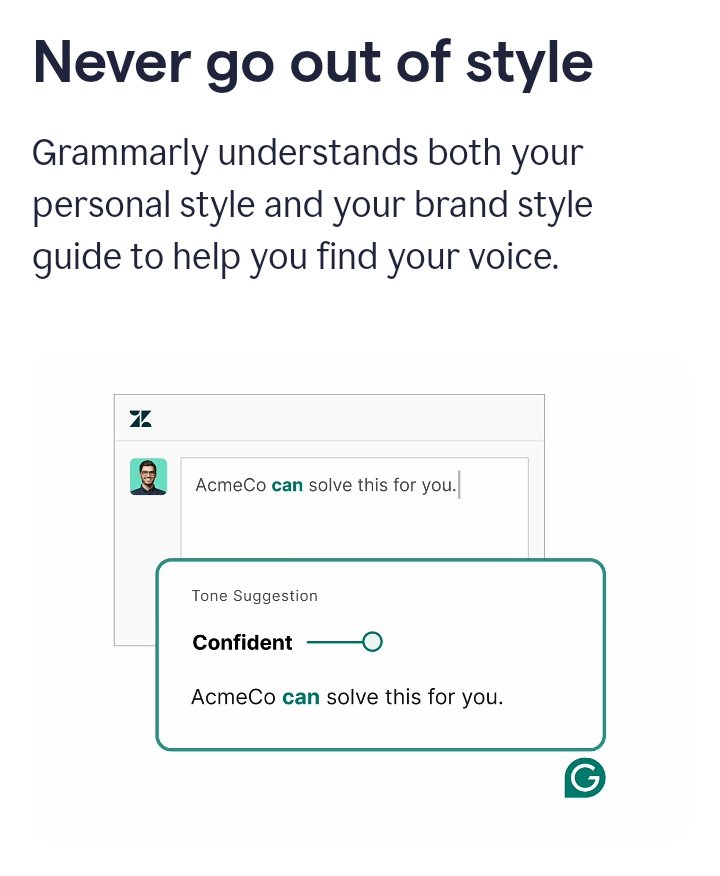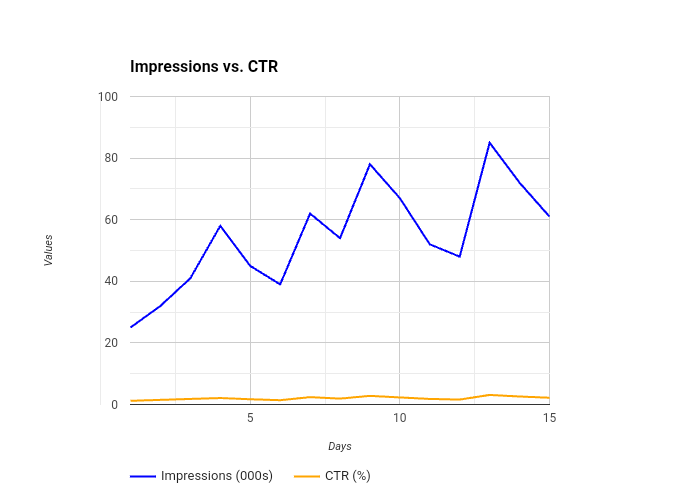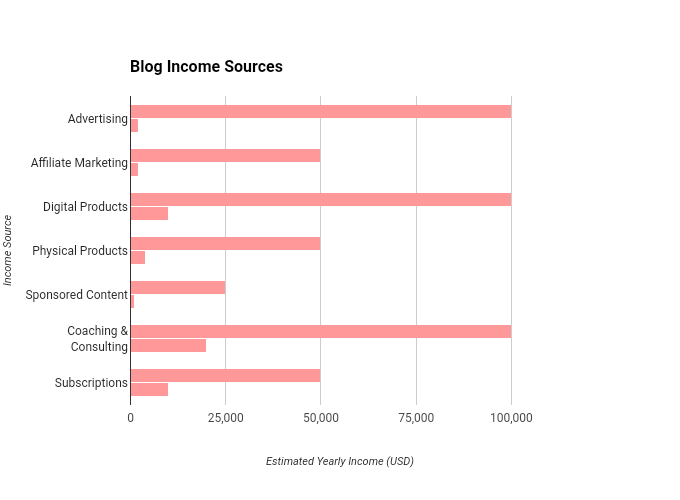Valuing your blog for sale requires careful consideration of various factors that contribute to its worth.
By taking these factors into account, you can ensure that you get a fair price for your blog. Here are some key factors to consider:
1. Traffic and Engagement
The amount of traffic your blog receives and the level of engagement from your audience play a crucial role in determining its value.
Buyers are interested in blogs that have a consistent flow of traffic and a highly engaged audience.
They want to see that your blog has a strong following and the potential for growth.
As we use tools like Google Analytics to gather data on your blog’s traffic and engagement metrics, such as
- page views
- unique visitors
- bounce rate
- social media shares
2. Content Quality
The quality of your blog’s content is another important factor to consider.
Buyers are looking for well-written, informative, and engaging content that resonates with the target audience.
They want to see that your blog provides value to readers not SEO and has a unique voice.
Assess the overall quality of your blog’s content, including the writing style, accuracy of information, and relevance to your niche.
3. Monetization Potential
Buyers are interested in blogs that have the potential to generate revenue.
Evaluate the monetization strategies you have implemented on your blog, such as
- display ads
- sponsored posts
- affiliate marketing
- selling digital products
- List go on – etc 😁
Provide evidence of your blog’s income, such as monthly revenue reports, to demonstrate its monetization potential.
Buyers will be more willing to pay a higher price if they see that your blog has a solid revenue stream.
4. Niche and Market Demand
The niche your blog operates in and the demand for content within that niche also influence its value ⚖️.
Blogs in popular niches with high market demand are more likely to attract buyers and command a higher price.
Research the current market trends and competition within your niche to gauge its demand.

As you can see some are rapidly growing and the other are down.
Consider the potential for growth and profitability in your niche when determining the value of your blog.
5. Branding and Reputation
Your blog’s brand and reputation are valuable assets that can impact its value.
Buyers are interested in blogs that have a strong brand presence and a positive reputation within the industry.
Assess your blog’s branding elements, such as logo, color scheme, and overall design. 💡
Additionally, consider the reputation you have built through collaborations, guest posts, or mentions on other reputable websites.
A well-established brand and positive reputation can increase the perceived value of your blog.
6. SEO and Backlinks
The search engine optimization (SEO) of your blog and the number of high-quality backlinks it has can also affect its value.
Buyers are looking for blogs that rank well in search engine results and have a strong backlink profile.
Evaluate your blog’s SEO efforts, including keyword optimization, meta tags, and internal linking.
Additionally, assess the number and quality of backlinks pointing to your blog from other authoritative websites.
A blog with strong SEO and backlinks is more likely to attract buyers and command a higher price.
By considering these factors and gathering relevant data, you can determine a fair value for your blog when selling it.
Remember to be realistic in your valuation and consider the market conditions and buyer’s perspective.
Ultimately, finding the right buyer who sees the potential in your blog and aligns with your vision is key to a successful sale.
1. Assess Your Blog’s Traffic
🚖
One of the first things potential buyers will look at when valuing your blog is its traffic.
The more traffic your blog receives, the more valuable it becomes.
Start 🚀 by analyzing your blog’s traffic data and identifying any patterns or trends.
Look at metrics such as monthly visitors, page views, and bounce rate. This information will give you a clear picture of your blog’s performance and help you determine its value.
Once you have gathered the necessary traffic data, it’s important to dig deeper and understand the sources of your blog’s traffic.
Are most of your visitors coming from organic search, social media platforms, or referral sites?
By identifying the primary sources of traffic, you can evaluate the sustainability and reliability of your blog’s audience.
Furthermore, consider examining the demographics of your blog’s visitors.
Are they predominantly from a specific country or region?
Understanding the geographical 🌍 distribution of your audience can help you assess the potential for growth and expansion in different markets.
In addition to traffic volume and sources, it’s crucial to evaluate the engagement level of your blog’s visitors. ⛷️
Look at metrics such as average time on page, number of comments, and social media shares.
These indicators 🚦 will provide insights into the level of interest and interaction your content generates.
A blog with highly engaged visitors is likely to be more appealing to potential buyers.
Another aspect to consider is the consistency and stability of your blog’s traffic.
Has your blog experienced any significant fluctuations or spikes in traffic?
Are there any seasonal patterns that affect your audience’s behavior?
Understanding the historical performance of your blog will give buyers a better understanding of its potential for long-term success.
Finally, it’s essential to compare your blog’s traffic data with industry benchmarks and competitors.
How does your blog’s performance stack up against similar blogs in your niche?
Are there any areas where you can improve to gain a competitive edge?
By positioning your blog within the broader context of the industry, you can provide potential buyers with a comprehensive overview of its value and potential.
However – assessing your blog’s traffic is a crucial step in determining its value.
By analyzing metrics, understanding traffic sources, evaluating engagement levels, considering demographics, 🌍 and comparing against industry benchmarks, you can paint a detailed picture of your blog’s performance and attract potential buyers who recognize its worth.

2: Content Analyzing🔍
When evaluating your blog’s content, it is essential to consider various factors that contribute to its overall quality and appeal.
Start by examining the writing style and language used in your articles.
Is it clear, concise, and free from grammatical errors?
Use grammerly.com to avoid any errors.

Ensuring that your content is well-written not only enhances the reader’s experience but also reflects your professionalism as a blogger. 👨🔧
In addition to the writing style, the information provided in your blog posts should be accurate, up-to-date, and relevant to your target audience.
Conduct a thorough review of the topics covered and assess whether they align with the interests and needs of your readers.
Are there any gaps in your content that you could fill with new articles or blog posts?
Identifying these opportunities will not only attract more readers but also demonstrate your expertise in the field.
Uniqueness is another critical aspect to consider when evaluating your blog’s content.
With countless blogs available on the internet, it is crucial to offer something distinctive to stand out from the competition.
Analyze your articles and blog posts to determine if they provide a fresh perspective, unique insights, or original research.
If you find that your content lacks originality, consider brainstorming new ideas or collaborating with other experts in your niche to create compelling, one-of-a-kind content.
While assessing your blog’s content, it is also essential to identify any standout articles or blog posts that have gained significant traction.
These high-performing pieces not only showcase your ability to create engaging content but also serve as valuable assets when attracting potential buyers.
Highlighting these top-performing articles on your blog’s homepage or creating a dedicated section to showcase them can increase the perceived value of your blog.
Ultimately, evaluating your blog’s content is a continuous process that requires ongoing refinement and improvement.
Regularly reviewing and updating your articles and blog posts will not only keep your content fresh and relevant but also increase its appeal to potential buyers.
By focusing on high-quality, engaging, and unique content, you can position your blog as a valuable asset in the competitive blogging market.
3. Consider Your Blog’s Monetization Potential
💸
Another important factor to consider when valuing your blog is its monetization potential.
How have you been monetizing your blog?
Are you earning revenue through advertising, sponsored posts, or affiliate marketing?
Evaluate the current monetization strategies you have in place and determine their effectiveness.
Additionally, consider the potential for future monetization.
Are there any untapped opportunities or new revenue streams that could be explored?
A blog with strong monetization potential will be more attractive to buyers.
When assessing your blog’s monetization potential, it is crucial to analyze your current revenue streams and their performance.
If you are generating income through advertising, evaluate the effectiveness of your ad placements, the number of impressions, and click-through rates.

Consider if there are any improvements you can make to optimize your ad revenue, such as experimenting with different ad networks or implementing native advertising.
Sponsored posts can also be a significant source of revenue for bloggers.
Assess the frequency and quality of sponsored content on your blog.
Are you consistently collaborating with reputable brands and producing engaging sponsored posts?
Evaluate the engagement metrics of these posts, including comments, social shares, and click-through rates, to gauge their effectiveness.

Additionally, consider if there is room for growth in this area by reaching out to more brands or expanding your niche.
Affiliate marketing is another avenue to explore when evaluating your blog’s monetization potential. Analyze your affiliate partnerships and the performance of the products or services you are promoting.
Look at the conversion rates, average order values, and commission rates to determine the profitability of your affiliate marketing efforts.
Consider if there are any untapped niches or products that align with your blog’s content and audience, which could potentially increase your affiliate revenue.
In addition to assessing your current monetization strategies, it is essential to consider the potential for future growth.
Are there any emerging trends or new revenue streams that you can tap into?
For example
if you have a strong presence on social media, you could explore opportunities for sponsored social media posts or influencer marketing collaborations.
Alternatively, you could consider creating and selling digital products, such as e-books, online courses, or membership subscriptions, to diversify your revenue streams.
Ultimately, a blog with a strong monetization potential will be more attractive to potential buyers.
By evaluating your current revenue streams, exploring untapped opportunities, and considering potential future growth, you can enhance the value of your blog and increase its appeal in the market.
4. Analyze Your Blog’s Social Media Presence
In today’s digital age, a strong social media presence is crucial for any successful blog and individual.

Evaluate your blog’s social media accounts and assess their performance.
Look at the number of followers, engagement rates, and reach.
A blog with a large and engaged social media following will have higher value.
Additionally, consider the potential for growth in your social media presence.
Are there any strategies you can implement to increase your following and reach?
Highlighting your blog’s social media success will make it more appealing to potential buyers.
When analyzing your blog’s social media presence, it’s important to consider the platforms you are using and how well they align with your target audience.
For example, if your blog focuses on fashion and lifestyle, platforms like Instagram and Pinterest may be more effective in reaching your desired audience compared to platforms like Twitter or LinkedIn.
To assess the performance of your social media accounts, start by looking at the number of followers or subscribers you have.
🦜🦜🦜🦜🦜
Metric will gives you an idea of the size of your audience and their level of interest in your content.
However, it’s not just about the quantity of followers, but also the quality.
Evaluate the engagement rates on your posts, such as the number of likes, comments, and shares.
A high engagement rate indicates that your audience is actively interacting with your content, which is a positive sign for potential buyers.
In addition to engagement, consider the reach of your social media accounts.
Reach refers to the number of people who see your posts, whether they are followers or not.
This metric gives you an idea of how far your content is spreading and how well it is resonating with a wider audience.
A blog with a high reach has the potential to attract more readers and potential buyers.
Once you have evaluated your blog’s current social media presence, it’s important to identify areas for improvement and growth.
Are there any strategies you can implement to increase your following and reach?
This could include creating a content calendar to ensure consistent posting, optimizing your social media profiles with relevant keywords and hashtags, engaging with your audience through comments and direct messages, collaborating with influencers or other bloggers in your niche, or running targeted advertising campaigns.
Highlighting your blog’s social media success can make it more appealing to potential buyers.
When marketing your blog for sale, emphasize the number of followers, engagement rates, and reach that your social media accounts have achieved.
This demonstrates the value of your blog and its potential for continued growth under new ownership.
In conclusion, analyzing your blog’s social media presence is essential for understanding its value and potential for growth.
By evaluating the number of followers, engagement rates, and reach of your social media accounts, you can identify areas for improvement and implement strategies to increase your following and reach.
Emphasizing your social media success when marketing your blog for sale will make it more appealing to potential buyers and increase its value in the marketplace.
Once you have identified blogs in your niche that have been sold recently, it’s important to dig deeper into the details of these sales.
Look for blogs that are similar in terms of size, audience demographics, and engagement levels.
This will give you a more accurate picture of what your blog could potentially sell for.
When analyzing the sale prices of comparable blogs, consider the factors that contributed to their value.
Traffic is a crucial factor to consider, as it indicates the level of interest and engagement your blog generates.
Look at the monthly page views, unique visitors, and bounce rate of the blogs you are researching.
These metrics will give you an idea of how popular and valuable your blog is compared to others in your niche.
Content quality is another important aspect to consider.
Evaluate the uniqueness, relevance, and depth of the content on the blogs you are researching.
High-quality content that provides value to readers is more likely to attract a higher sale price.
Assess the blog’s writing style, use of visuals, and overall user experience to determine its content quality.
Monetization potential is a key factor that potential buyers will consider when evaluating your blog. Look at the different revenue streams the blogs you are researching have in place.
Are they generating income through display advertising, sponsored posts, affiliate marketing, or selling products/services? Analyze the blog’s revenue sources and their profitability to get an idea of its monetization potential.
Social media presence can also influence the value of a blog.
Evaluate the blog’s presence on platforms such as Facebook, Instagram, Twitter, and Pinterest.
Look at the number of followers, engagement levels, and the overall branding and messaging on these platforms.
A strong social media presence can indicate a loyal and engaged audience, which can add value to your blog.
By thoroughly researching comparable blog sales and analyzing the factors that contributed to their value, you can set a competitive price for your own blog.

Keep in mind that pricing your blog too high may deter potential buyers, while pricing it too low may undervalue your hard work and potential.
Strike a balance based on the research you have conducted and the unique qualities of your blog.
6. Seek Professional Advice
If you’re unsure about how to value your blog or want an expert opinion, consider seeking professional advice.
There are professionals who specialize in blog valuations and can provide you with an accurate assessment of your blog’s worth.
They will take into account all the relevant factors and provide you with a fair valuation.
While this may incur some cost, it can save you from undervaluing or overvaluing your blog.
Seeking professional advice can be a wise decision, especially if you have limited knowledge or experience in blog valuations.
These professionals have the expertise and market insights to evaluate your blog objectively.
They will consider various factors such as your blog’s traffic, engagement metrics, niche, monetization strategies, and potential for growth.

When consulting with a professional, it’s important to provide them with as much information as possible.
This includes access to your blog’s analytics, revenue reports, and any other relevant data.
The more comprehensive the information you provide, the more accurate their valuation will be.
Additionally, professional blog valuers can offer valuable guidance on how to maximize the value of your blog.
They can provide recommendations on improving your content, increasing your audience reach, and optimizing your monetization strategies.
Their insights can help you make informed decisions to enhance the profitability and long-term sustainability of your blog.
It’s worth noting that the cost of professional blog valuation services can vary depending on the complexity of the evaluation and the reputation of the valuer.
However, the investment can be worthwhile, as it can help you negotiate better deals if you decide to sell your blog in the future or attract potential investors.
When choosing a professional blog valuer, it’s essential to do your research and select someone with a proven track record in blog valuations.
Look for testimonials, reviews, and recommendations from other bloggers who have used their services.
You want to ensure that you’re working with someone who is trustworthy, knowledgeable, and experienced in the field.
In conclusion, seeking professional advice for blog valuation is a prudent step to take if you want an accurate assessment of your blog’s worth.
These experts can provide you with valuable insights, help you avoid undervaluing or overvaluing your blog, and offer guidance on how to maximize its value.
Consider investing in professional blog valuation services to make informed decisions about the future of your blog.




